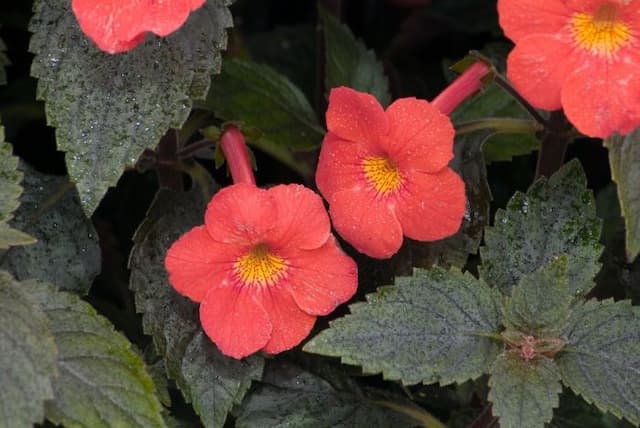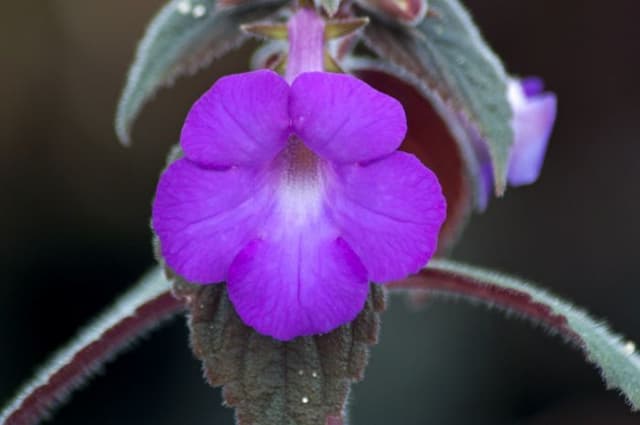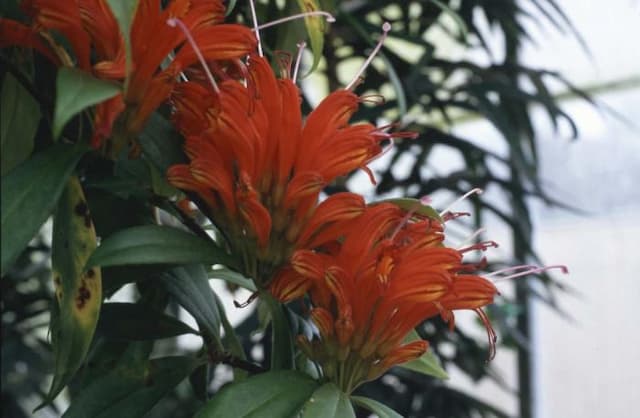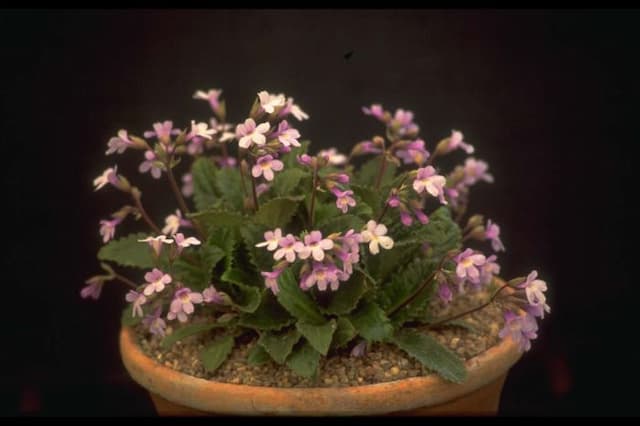Lavender Chirita Microchirita lavandulacea

ABOUT
Microchirita lavandulacea, commonly referred to as the Lavender Microchirita, is a delicate herbaceous plant known for its attractive foliage and flowers. The leaves of the Lavender Microchirita are velvety to the touch, featuring a rich green hue with a soft, almost fuzzy texture. These leaves are typically elongated with a serrated edge, coming to a point at the tip. The blooms of the plant are particularly eye-catching, displaying tubular flowers that resemble small trumpets. The petals of these flowers are a soft lavender color, which is how the plant derives its common name. The inside of the flower tube often exhibits delicate white or pale yellow markings, adding contrast and depth to its overall appearance. The Lavender Microchirita forms a neat, compact shape, tending to grow in a bushy manner with its stems and leaves arranged close together, creating a lush appearance. This plant blossoms periodically, and when in bloom, it provides a splash of color that makes it stand out in any collection of houseplants or within a garden setting. While the size of the Lavender Microchirita is not discussed, its aesthetic characteristics make it a charming addition where it can flourish under the right conditions.
About this plant
 Names
NamesFamily
Gesneriaceae
Synonyms
There are no commonly recognized common names for Microchirita lavandulacea outside of its scientific name.
Common names
Chirita lavandulacea, Chirita lavandulacea var. pterocaulis.
 Toxicity
ToxicityTo humans
There is limited information available on the toxicity of Microchirita lavandulacea, also known as Lavender Chirita, to humans. As with any plant, it is advisable to exercise caution and keep it out of reach of children who might ingest it by accident. If you suspect poisoning from any plant, it is important to seek medical advice promptly.
To pets
Toxicity information regarding Microchirita lavandulacea, commonly referred to as Lavender Chirita, for pets is not well-documented. Pet owners should act with caution and prevent pets from ingesting plants that have not been verified as safe. If you suspect your pet has ingested part of this plant and is showing adverse symptoms, contact your veterinarian or an animal poison control service immediately. Symptoms of plant poisoning in pets can vary but often include vomiting, diarrhea, lethargy, or more severe reactions depending on the level of toxicity.
 Characteristics
CharacteristicsLife cycle
Perennials
Foliage type
Evergreen
Color of leaves
Green
Flower color
Blue
Height
6 inches (15 cm)
Spread
12 inches (30 cm)
Plant type
Herb
Hardiness zones
11
Native area
Southeast Asia
Benefits
 General Benefits
General Benefits- Ornamental Value: Microchirita lavandulacea, often referred to as Lavender Chirita, adds aesthetic appeal to gardens and indoor spaces with its beautiful lavender-colored flowers.
- Habitat for Wildlife: It can provide a micro-habitat or food source for small insects and pollinators, supporting local biodiversity.
- Low Maintenance: Lavender Chirita is relatively easy to care for, requiring minimal maintenance and making it suitable for novice gardeners.
- Adaptability: This plant can thrive in a variety of environments, from indoor pots to outdoor shaded areas, provided it has the right conditions.
- Stress Reduction: The presence of plants like Lavender Chirita in living or working spaces can help reduce stress and improve mental well-being.
 Medical Properties
Medical PropertiesThis plant is not used for medical purposes.
 Air-purifying Qualities
Air-purifying QualitiesThis plant is not specifically known for air purifying qualities.
 Other Uses
Other Uses- Ornamental Value: Microchirita lavandulacea, commonly known as Lavender Fameflower, is often grown for ornamental purposes due to its attractive foliage and delicate purple flowers.
- Bonsai Specimen: Due to its small size and attractive shape, Lavender Fameflower can be cultivated as a miniature bonsai.
- Educational Tool: Lavender Fameflower can be used in botanical education to help students learn about the Gesneriaceae family and the care of small perennials.
- Photographic Subject: Its vibrant bloom and foliage make it a favorite among photographers, especially those specializing in macro photography.
- Terrarium Plant: The Lavender Fameflower's compact growth form makes it suitable for inclusion in moist terrariums where it can thrive in high humidity conditions.
- Fairy Gardens: Its small size can complement fairy gardens, creating a whimsical landscape that is in scale with miniature fairy structures.
- Window Boxes: Due to its modest root system, it can be planted in window boxes where its flowers can be admired up close.
- Crafting: The flowers and leaves can be used in dried flower arrangements or other craft projects that require small floral components.
- Color Contrast: Gardeners can use Lavender Fameflower to create color contrast in mixed plant containers or beds.
- Stress Relief: Caring for and observing the growth of plants like the Lavender Fameflower can be a relaxing hobby, which provides aesthetic pleasure and stress relief.
Interesting Facts
 Feng Shui
Feng ShuiThe Microchirita is not used in Feng Shui practice.
 Zodiac Sign Compitability
Zodiac Sign CompitabilityThe Microchirita is not used in astrology practice.
 Plant Symbolism
Plant Symbolism- Delicacy: Microchirita lavandulacea, commonly known as Lavender Chirita, has a gentle and delicate appearance, symbolizing the finer and more delicate aspects of situations or relationships.
- Peace: The soft lavender color of the plant is often associated with tranquility and calmness, representing a desire for peace in one's life.
- Healing: Lavender plants in general are commonly associated with healing due to their use in aromatherapy and traditional medicine, and although Microchirita lavandulacea is different, it may still carry this symbolism.
- Beauty: The aesthetic appeal of the Lavender Chirita's blooms can symbolize beauty and grace in various cultures.
- Serenity: The Lavender Chirita can also represent a state of serenity or the quest for calm in the midst of chaos, often encouraged by the soothing color of its flowers.
 Water
WaterThe Microchirita, commonly known as Lavender Lace, prefers consistently moist soil, so it should be watered once the top inch of the soil starts to feel dry, which is typically once a week. However, the frequency can change depending on environmental conditions like temperature and humidity, with more frequent watering required in warmer, drier conditions. It's important to water this plant with care to avoid waterlogging; using about 8 ounces of water each time should be sufficient. Ensure that the pot has good drainage to prevent excess water from sitting at the roots, which can lead to root rot.
 Light
LightLavender Lace thrives in bright, indirect light but can tolerate medium light levels. The ideal spot for this plant would be near an east or north-facing window where it can receive a good amount of morning light without the harshness of direct afternoon sun. Avoid placing it in full sunlight, as this can scorch the leaves and compromise the plant's health.
 Temperature
TemperatureLavender Lace thrives in a temperature range between 60 and 80 degrees Fahrenheit. The plant can survive minimum temperatures down to about 50 degrees Fahrenheit, but growth may slow down. Avoid exposing Lavender Lace to temperatures below 50 degrees Fahrenheit or extremes above 80 degrees Fahrenheit for extended periods to prevent stress and damage.
 Pruning
PruningPruning the Lavender Lace is beneficial to maintain a bushy and attractive shape and to remove any dead or yellowing leaves. The best time to prune is in the spring, as the plant enters its active growing period. It should be pruned lightly and only as needed to shape the plant or remove occasional dead foliage. Do not over-prune, as this can stress the plant and reduce its vitality.
 Cleaning
CleaningAs needed
 Soil
SoilThe best soil mix for Microchirita lavandulacea, commonly known as Lavender Rabbit Ears, is a well-draining mix with high organic content such as peat or coir blended with perlite or vermiculite. The soil pH should be slightly acidic to neutral, ideally ranging between 6.0 and 7.0 to mimic the plant's natural environment.
 Repotting
RepottingLavender Rabbit Ears should be repotted every one to two years or when it has outgrown its pot. It's best to repot in the spring, just before the growth season begins, to minimize stress and to allow the plant to establish in its new container more easily.
 Humidity & Misting
Humidity & MistingLavender Rabbit Ears prefer high humidity levels, thriving at around 60-80%. Maintaining proper humidity is crucial for this plant's health, so it may benefit from placement on a pebble tray with water or regular misting to emulate a humid environment.
 Suitable locations
Suitable locationsIndoor
Place in bright, indirect light and keep soil moist.
Outdoor
Only in warm climates; sheltered, partial shade area.
Hardiness zone
10-11 USDA
 Life cycle
Life cycleMicrochirita lavandulacea, also known as Lavender Rabbits Ears, starts its life as a seed, which upon finding favorable moist and warm conditions, will germinate and sprout. The seedling will develop into a juvenile plant, establishing a rosette of furry, lavender-like leaves and beginning to form a small root system. As it matures, it produces stems with opposite leaves and eventually the characteristic blue to purple flowers that are tubular and bilaterally symmetrical, attracting pollinators for reproduction. After pollination, the flowers set seed within small capsules, completing the reproductive phase. The plant may then enter a period of dormancy, especially if it experiences unfavorable conditions such as drought. Over time, the mother plant may produce offsets or can be propagated vegetatively, while the dispersed seeds will give rise to the next generation, continuing the cycle.
 Propogation
PropogationPropogation time
Spring-Early Summer
Microchirita lavandulacea, commonly known as Lavender Pearls, is often propagated through leaf cuttings, the most popular method for this plant. The ideal time for propagation is during the warm growing season, generally in spring or early summer, when the plant is actively growing. To propagate by leaf cuttings, a healthy leaf with a petiole is chosen and cut from the mother plant. The cut end of the petiole, typically around 1-1.5 inches (2.5-3.8 centimeters), is then dipped in rooting hormone to encourage root development and planted in a moist, well-draining potting mix. The cutting should be placed in a warm, bright location, avoiding direct sunlight, and kept uniformly moist. Roots usually develop within a few weeks, after which point the new young plant can gradually acclimate to normal growing conditions.









